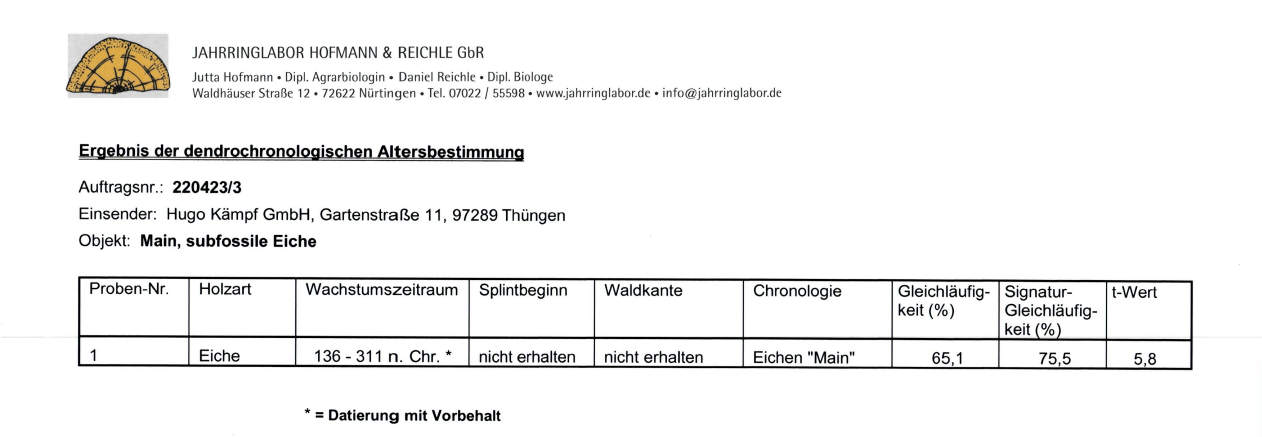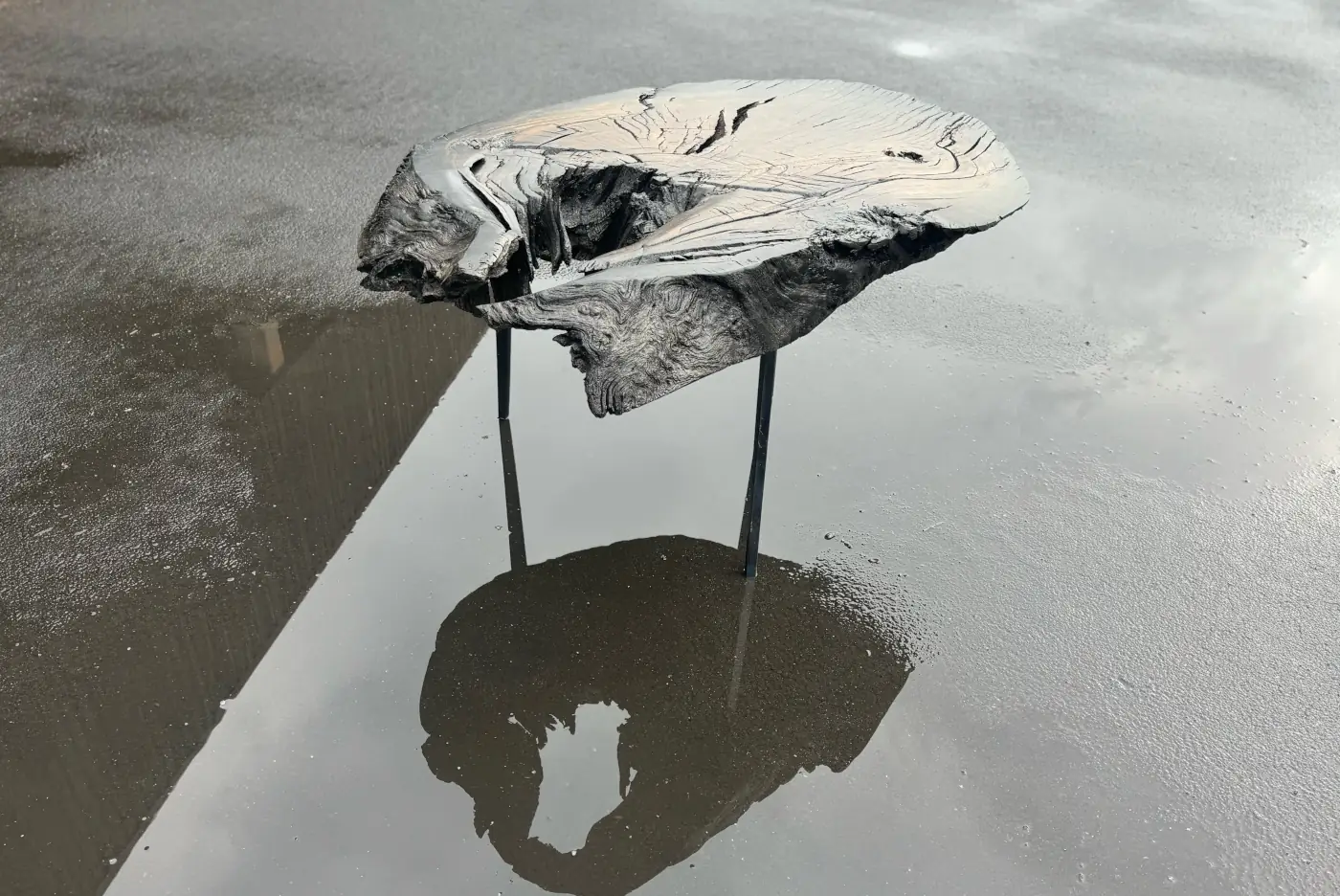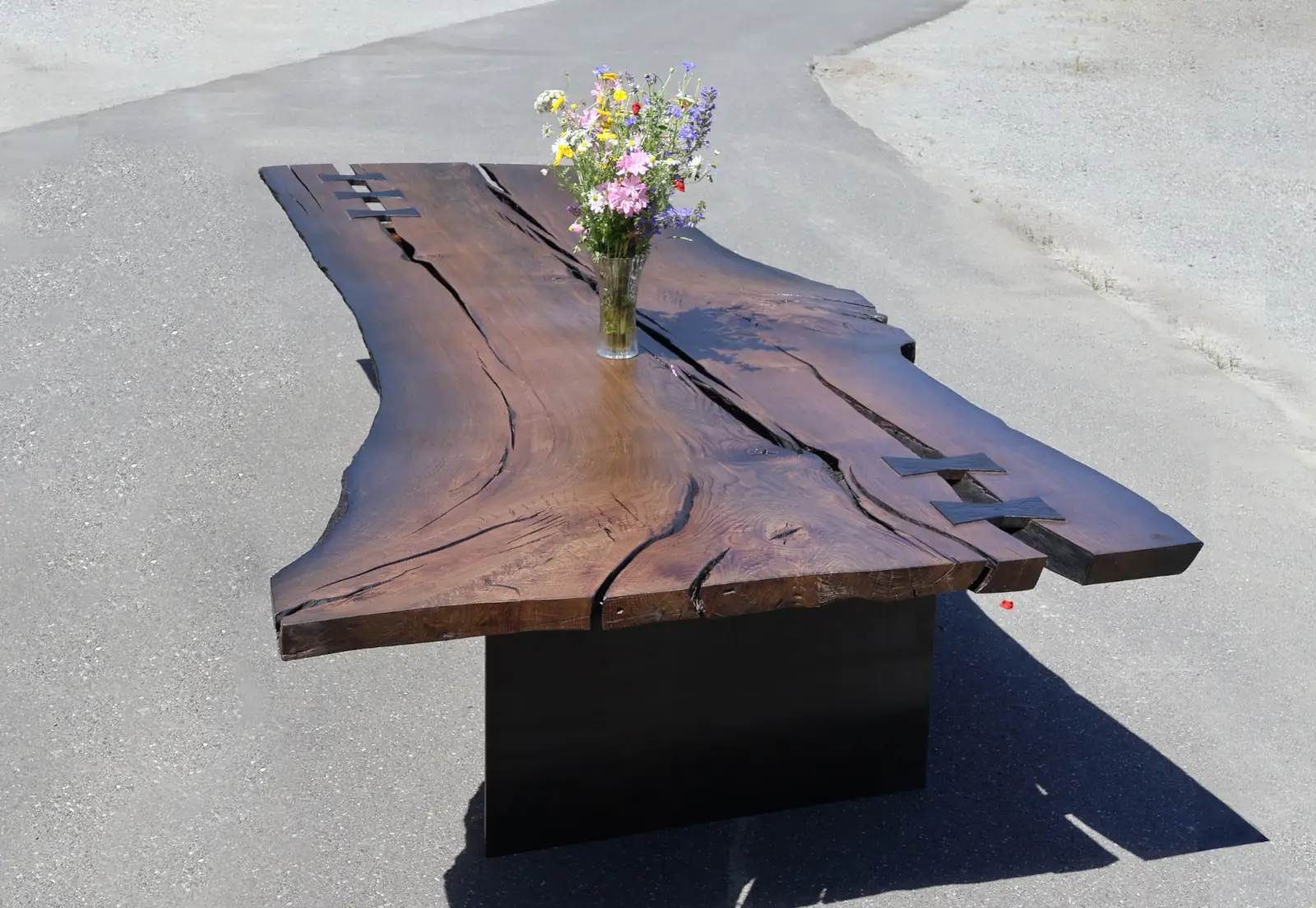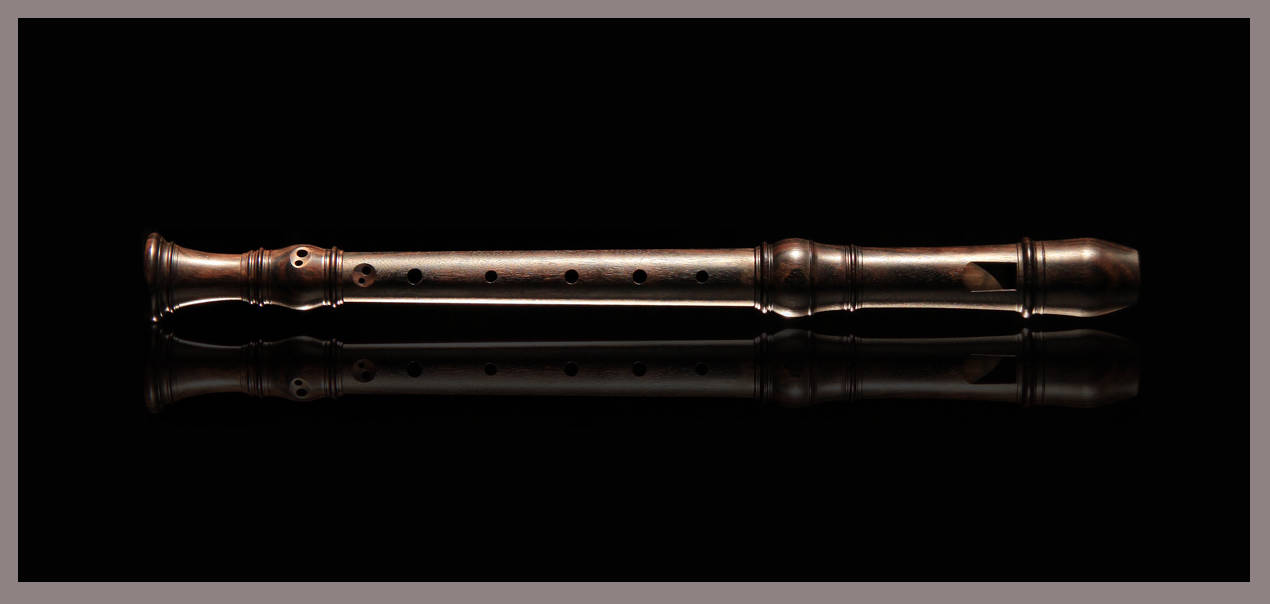Bog oak | Photo © by Hugo Kämpf
Bog oak is an extraordinary natural phenomenon, created through a unique combination of time, nature, and chemical processes. When an oak tree sinks into a bog, it remains preserved under oxygen-deprived conditions for millennia. Layers of peat encase the tree, protecting it from decay. Simultaneously, chemical reactions between iron and humic acids, along with the mineral properties of the bog, initiate a transformation process that densifies and hardens the wood while giving it its distinctive dark color.
This process can span thousands of years, making bog oak a rare and valuable natural material. Its fascinating coloration—ranging from deep black to shimmering brown tones - tells the story of its formation and serves as a symbol of nature's patience.
The Role of Minerals and Humic Acids
The dark hue of bog oak results from chemical reactions between iron in the bog water and the natural tannins in the wood. These interactions produce iron-tannin complexes, which turn the wood anthracite to jet black. The intensity and variety of colors depend on the soil composition and the length of time the wood has been submerged.
The Story of a Millennia-Old Tree
Every piece of bog oak tells a story that reaches far into the past. As "subfossil oak," it carries not only the memories of its growth period but also traces of a long-gone climate era.
An impressive example: An oak germinated in 2907 BCE, grew for 384 years, and then fell into a bog, either due to a storm or unstable ground. There, it sank deeper into the peat and was excluded from oxygen for millennia. While humanity advanced and civilizations rose and fell, the bog oak lay undisturbed in its natural shelter.
The bog oak’s color palette - from silvery gray shades to bluish-black tones and muddy green accents - reflects this long journey. It makes each piece of wood a unique testament to natural history, fascinating scientists, artists, and craftsmen alike.
Properties of Bog Oak
Visual Characteristics:
The appearance of bog oak is unparalleled. Its deep dark color and finely defined grain give the wood an elegant and mysterious look. As every bog oak forms under unique conditions, its coloration varies greatly—from rich black to warm brown and metallic hues. This interplay of colors makes bog oak a sought-after material for art and craftsmanship.
Physical Properties:
Bog oak is denser and heavier than regular oak. Its prolonged preservation in the bog enhances its stability but reduces its elasticity. While robust, the wood requires meticulous handling, as it is sensitive to sudden changes in moisture and temperature.
Chemical Characteristics:
In addition to its remarkable hardness, bog oak's chemical composition stands out. Embedded minerals and humic acids influence not only its color but also its structure. Scientists use these features to deduce the climatic and geological conditions of the wood's time in the bog.
Dating Bog Oak

Dendrochronological Dating | Photo © by Hugo Kämpf
Determining the age of a discovered bog oak is essential to understanding its historical significance and the context of its formation. This process combines modern scientific methods with a deep appreciation for natural history.
Two primary methods are employed:
- Dendrochronology: By examining the tree rings, researchers can precisely date the oak by comparing its growth conditions with existing chronologies. This method can pinpoint the exact year of the bog oak's formation.
- Radiocarbon Dating (14C Dating): Measuring the decay of the radioactive carbon isotope 14C allows scientists to estimate the age of wood, even in heavily damaged or incomplete samples. This method provides a reliable, albeit broader, timeframe.
These complementary methods enable comprehensive dating, providing valuable insights into climate history, historical events, and environmental conditions during the wood’s growth period. They also increase the scientific, cultural, and material value of bog oak for research, restoration, or craftsmanship.
 Side table made from bog oak | Photo © by Hugo Kämpf
Side table made from bog oak | Photo © by Hugo Kämpf
Usage and the Art of Bog Oak
Archaeological Treasures:
Some of the most significant archaeological discoveries feature bog oak, often used in prehistoric structures or tools. These finds provide glimpses into the lives and cultures of past civilizations.
Historical Applications:
In the Middle Ages, bog oak was already valued for ceremonial and sacred purposes. Its dark color and rarity symbolized power and permanence, making it a preferred material for altars, thrones, and religious carvings.
Modern Uses: Sculptures, Furniture, and Tables:
For centuries, bog oak has inspired artists and craftsmen. Its dark, mystical aesthetic is particularly suited for sculptures. Furniture made from bog oak—ranging from exquisite cabinets to artistically crafted chairs—combines history and elegance.

Dining table made of bog oak | Photo © by Hugo Kämpf
A standout example is bog oak tables. These pieces embody timeless beauty and unmatched craftsmanship. Each table is unique, with grain patterns and color influenced by the wood’s formation conditions. The dark hues and intricate textures give such tables an extraordinary presence, whether in modern or classic interiors. Bog oak tables are often paired with glass or metal for a striking contrast between the wood’s ancient origin and contemporary design.
Historical Discoveries
Over 3000-Year-Old Bog Oak in the Ampermoos
Bog oaks are not only impressive natural phenomena but also vital witnesses to the past. In the Ampermoos near Kottgeisering, a remarkable piece of bog oak was discovered: a more than 3000-year-old oak wood disk preserved in the bog soil. This find was made by chance during drainage work and later examined by the Historical Society of Fürstenfeldbruck.
Dendrochronological analysis dated the oak to the year 1077 BCE. Whether the tree was felled by a storm or destroyed by lightning remains unclear. Although no traces of human craftsmanship were found, this discovery remains of great significance to science. It provides insights into the vegetation and environmental conditions of a time over three millennia ago.
A Treasure at Pilzhof Steidle
Another fascinating example of bog oak finds comes from Rudi Steidle in Grasbeuren. Behind his house, he discovered a bog oak of impressive dimensions: ten meters long, eight tons in weight, and likely over 3000 years old.
This find was not just the result of a lucky coincidence but also the fulfillment of a dream for Steidle, who has been collecting and working with bog oaks for decades. As early as the 1970s, he began processing smaller pieces into artworks and furniture. With this large bog oak, he plans to create an exhibition focusing on the wood and its history. Particularly impressive is how Steidle treats the wood with respect: before processing, he allows the natural shape and structure of the wood to inspire him, capturing its aesthetics and millennia-old history in his creations.
The Wetzikon Bog Oak – 4200 Years Old
Another extraordinary find originates from Wetzikon in Switzerland. In 1985, a bog oak was discovered on the edge of a swamp, and its age was determined by radiocarbon analysis to be 4230 ± 85 years. Dendrochronological examination revealed that the tree germinated in 2907 BCE and lived for about 384 years before it fell into the bog around 2500 BCE.
The find was utilized by both scientists and artists: a cross-section of the trunk is now displayed in the municipal building of Wetzikon, while part of the trunk was processed into planks in a sawmill. The artist Roland Erne created unique artworks from the wood and even experimented with crafting musical instruments.
Flutes Made of Bog Oak – An Unusual Fusion of Art and Sound
A particularly remarkable use of the Wetzikon bog oak was found in instrument making. Flute maker Gerhard Huber crafted recorders from the ancient wood—a challenging task, as oak wood is typically unsuitable for flute construction. The coarse-pored wood required special techniques, but the result was surprising: the flutes produced a warm, soft tone that reflects the unique history of the material.
 Soprano recorder | Photo © by Gerhard Huber
Soprano recorder | Photo © by Gerhard Huber
These "Ancient Flutes" Became Coveted Collectibles. With their unique appearance, characterized by the deep black coloration of the wood, and their intricate craftsmanship, these flutes bridge the gap between past and present. Each flute was adorned with individual carvings inspired by hieroglyphs and ancient symbols, emphasizing the connection to the millennia-old origin of the wood.
Economic Aspects
Bog oak is not only scientifically and artistically significant but also a sought-after luxury good on the market. Its rarity, extraordinary appearance, and long formation history make it a valuable material, primarily traded in exclusive niches.
Market Value and Price Range
The value of bog oak varies significantly and is determined by several factors:
- Age and Origin: Older bog oaks with precise age determination through dendrochronological analyses are especially valuable. Wood from renowned sites like the Ampermoos or Wetzikon often commands higher prices.
- Wood Quality: The integrity and structure of the wood are crucial. Crack-free pieces with uniform grain and deep black coloration are the most sought after.
- Processing Potential: Large, well-preserved trunks suitable for furniture making or artwork have a higher market value than smaller, fragmented pieces.
In the trade, prices can range from €3000 to €10,000 per cubic meter, depending on quality. Particularly rare pieces suitable for artisanal projects can fetch significantly higher prices.
Factors Influencing Value:
- Origin and Discovery Circumstances: Bog oaks recovered under controlled conditions with documented history achieve higher prices. Finds made by chance can be harder to verify and are therefore less desirable.
- Workability: Since bog oak often contains cracks, its value is strongly influenced by its ease of processing. Craftsmen and buyers prefer pieces with minimal internal stresses that allow stable workability.
- Appearance: The dark coloration and unique grain are central value factors. Wood with deep black tones formed in iron-rich bogs is particularly in demand.
- Rarity and Demand: As bog oak finds are rare and the formation of new trunks takes millennia, supply is extremely limited. At the same time, demand, particularly in the exclusive furniture and art sectors, continues to rise, driving prices even higher.
Sustainability and Trade
As bog oak is a non-renewable resource, sustainable practices are increasingly required in many countries. Uncontrolled finds, where no conservation measures are taken, represent a loss for science and culture. Many traders and buyers, therefore, prioritize documented finds that are ethically and environmentally responsibly recovered.
Challenges in Excavating Bog Oak
The excavation of bog oak is a technically demanding and highly sensitive process. The trunks are often buried deep in bogs, riverbeds, or under tons of soil, making them difficult to access. To recover the wood undamaged, specialized equipment is required, such as excavators with fine tools or lifting devices that minimize pressure on the fragile material.
Modern Technologies for Excavation:
- Surveying Technologies: Laser scanning and ground-penetrating radar enable precise localization of the bog oak in the ground, helping to avoid damage from uncoordinated digging.
- 3D Models: These can visualize the shape and weak points of the wood, supporting strategic planning of the excavation.
- Specialized Equipment: Hydraulic excavators with fine gripping arms or specific lifting tools stabilize the wood during the recovery process.
Careful Drying and Preservation
After excavation, the delicate step of drying begins. Technologies such as vacuum dryers or climate-controlled drying chambers regulate moisture and temperature to prevent cracks in the wood. Additionally, digital sensors can monitor the drying process to detect potential problems early. Finally, the wood is preserved with natural oils or polymer impregnations to protect its structure over the long term.
Thus, the excavation and processing of bog oak require not only technical expertise but also careful planning and patience to preserve this rare cultural treasure in the best possible condition.
Conclusion – The Uniqueness of Bog Oak
Bog oak is an impressive natural wonder that connects past and present. It is a valuable material for science, art, and craftsmanship, distinguished by its history and aesthetic diversity. Preserving it requires not only technical expertise but also the responsibility to protect bogs as habitats and natural archives.
Frequently Asked Questions (FAQs)
How old is the oldest known bog oak?
The oldest bog oak has been dated to over 6000 years.
- Can bog oak be used for furniture?
Yes, bog oak is a popular material for exclusive furniture, especially for tables and inlays. - Why is bog oak so difficult to work with?
Its density and sensitivity to temperature fluctuations require careful processing. - What makes bog oak so special?
Its rarity, deep dark coloration, and millennia-long formation history distinguish bog oak from other woods. - Where can bog oak be found?
Bog oaks are primarily found in bogs and riverbeds, often in Germany, Switzerland, and Northern Europe.
Related Article:
Sources:
https://www.uni-bamberg.de/iadk/denkmalwissenschaften/dendro/dendrochronologie-methode/






